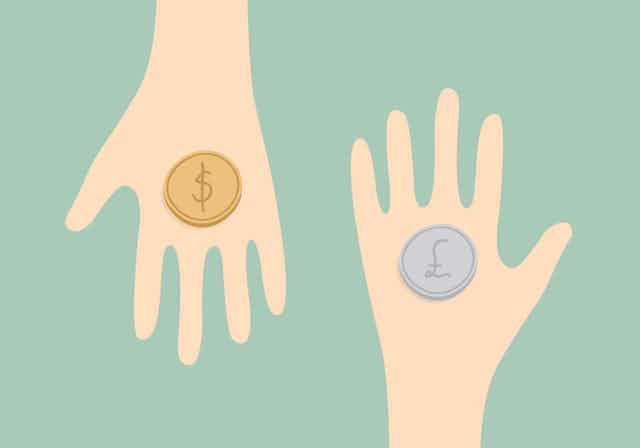Even before the UK’s Brexit vote was official, the pound’s value plummeted. It has been much reported that sterling has hit record lows. A look at the history of British currency crises shows how dramatic the shock was. That’s not to say Brexit has precipitated a full blown crisis, but a sterling recovery in the short term is not to be expected.
The pound fell to £1 to US$1.28 in the two weeks after the Brexit result. This has only been reached once in all the time these two currencies have existed – for a two-year period in the 1980s. And in the 1980s, the low rate was not due to a fundamentally weak pound, but to a strong dollar. All European currencies at the time fell against the dollar and were saved in 1985 by the Plaza Accord, a commitment by the US and Europe’s major economies to support their currencies through market intervention.
Apart from this brief episode between 1984 and 1985, sterling is now at its lowest against the US dollar since 1792, when the first American dollar was minted. The morning after the announcement of the Brexit result on June 24, sterling had dropped 10% overnight and was down 8% at the end of the trading day. Only four times since 1900 did the pound drop so much in one day – in 1931, 1940, 1949 and 1967. Two of these four falls were government induced devaluations.

In 1967 the British government decided to devalue sterling after several years of poor economic performance, mirroring the declining role of Britain in the world. After several dramatic rescue packages by industrialised countries from 1962-67, sterling was devalued by 14.3%. It led to considerable unrest on dollar and gold markets.
Before then, in 1949, at the insistence of the US, the British government decided to reduce the value of sterling by 30%. The world order had changed after the war and the US had a stronger economic position which needed to be reflected in its currency. Most European nations at the time followed this move and it had a rather positive consequence overall, even if the government was pushed to devalue after the Bank of England had lost money maintaining sterling’s parity with the dollar.
In 1931, the situation was in some ways similar to today. The unexpected shock of the Great Depression forced the British government to devalue sterling against its will. The shock, however, was much more violent and had disastrous global consequences as sterling was a major international currency. Britain was forced to abandon the gold standard, after having officially re-established a parity with gold in 1925. The devaluation marked the beginning of harmful currency and trade wars – something we do not want to see repeated in the wake of Brexit.

Thankfully today, trade wars are unlikely to happen as the World Trade Organisation, built up from 1948 and formally established in 1995, forces all nations to a minimum set of trade agreements. The institution is partly a legacy from the competitive policies of the Great Depression and ensures that none of the signatory parties engages in harmful trade wars. Similarly, the IMF, also created after the events of the Great Depression, is making sure that countries do not engage in currency wars, artificially devaluing currencies to make their exports cheaper.
The fourth time that the pound fell so badly followed the aftermath of Germany’s invasion of France in 1940, which pushed the pound down by almost 10%, just short of the drop the night of the Brexit result.
Crisis or short-term crash?
All the big shocks in the post-war years have been parallel to a progressive decline in the British colonial empire. Is this sterling drop to be the last nail in the coffin of Great Britain slowly becoming little England? To understand this, it’s important to recognise whether the main consequences of Brexit are only on the currency or also on the real economy.
Harvard economists Carmen Reinhart and Ken Rogoff define currency crashes as any drop of 15% over a year. By these measures, the aftermath of Brexit can be seen as a currency crash. However, it is not yet a full-blown crisis, as the impact on the economy is not yet clear. A lower pound might be good for British exports, but not for housing or finance.
This raises the question of whether the Bank of England will intervene and start buying sterling with its dollar reserves to avoid the pound from falling further. The decision would have to come from the Treasury, which is in charge of foreign exchange policy.
Latest foreign currency reserve figures published at the end of June showed that British reserves actually increased between May and June, in line with the trend of previous months. This would indicate that the Bank of England did not use its dollar reserves to support the pound. This has been the Bank’s policy since shortly after 1992, when it lost £3.3bn to speculators on Black Wednesday.
What would help sterling recover is positive news about the balance of payment (the current account deficit sat at £32.6 billion in March 2016), a rise in interest rates or overall economic growth. But due to all the economic and political unrest following Brexit, none of this is likely to happen in the near future so a further depreciation can be expected.

